I am just writing in a notebook – sometimes just a brief response to a small but intense experience; or a much more detailed account of a longer journey.
Source: About

Santiago de Chile. One last day before the journey to the fin del mundo is over. We don’t know the city at all and it seems too huge for a quick sample, so instead we plan a day trip to the coast and drive through the flowering fields of Californian poppy, vines, orchards and a national park forest to the port city of Valparaiso.
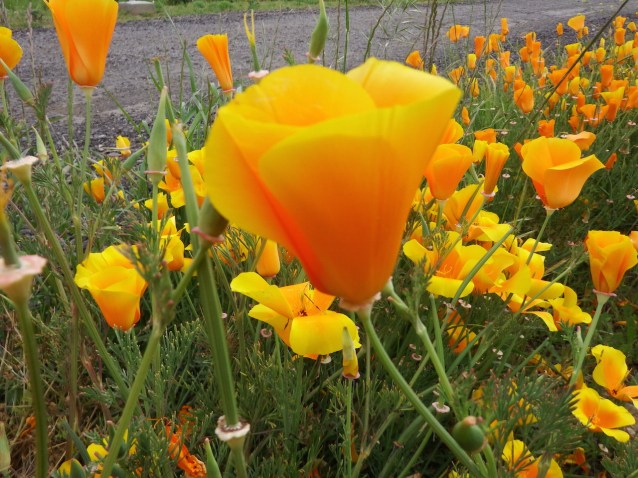
“Valpo” has been described as gritty and groovy. It is both. Many of the city’s iconic and historical neighbourhoods and buildings have seen better days.
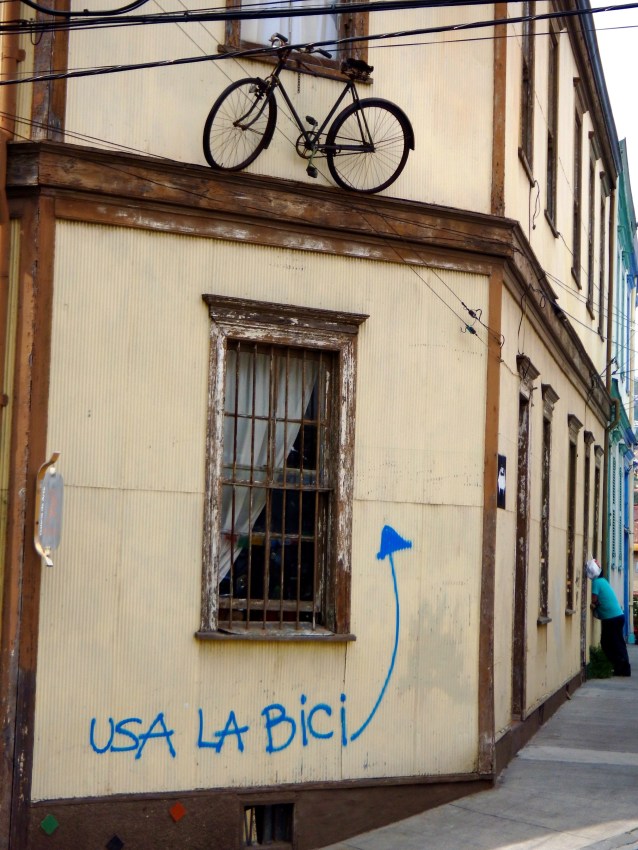
Prior to the opening of the Panama Canal it was certainly a very significant 19th Century port town and the architecture reflects the influence of its European immigrants and also, its naval importance.
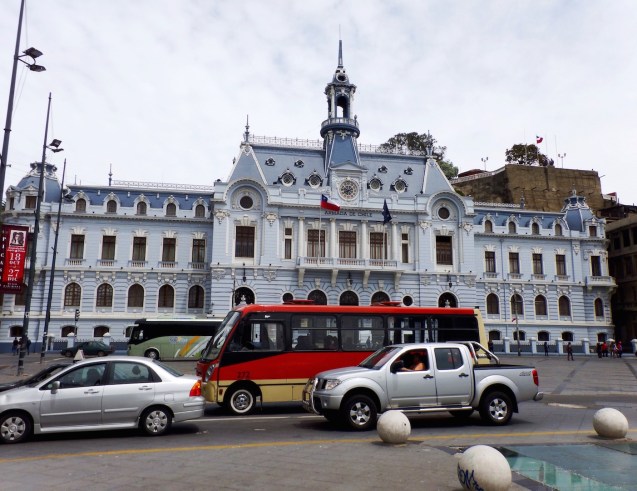
There is now much urban renewal and the fortunes of the city are again rising. Many of the buildings in the faded hilltop “hoods” are being revitalised.

Valparaiso is definitely on the tourist route in summer.

With its historical buildings and monuments, arts scene, shops, cafes, bars, boutique hotels and nightlife it does not disappoint.
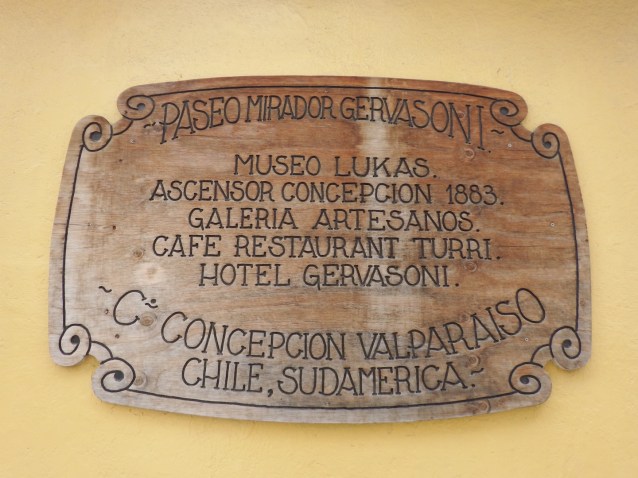
The funiculars – the oldest operating since 1883 – provide quirky, creaky access to locations such as Cerro Concepcion.

Side by side are beautifully restored colonial buildings, brightly painted houses with their bohemian vibe, walls of street art and political graffiti.
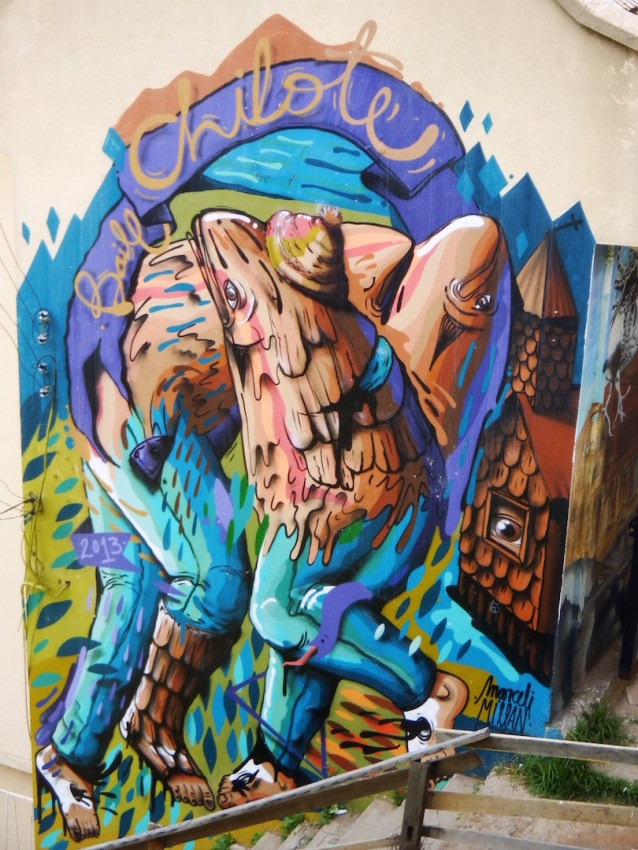
As in many other places in South America, sleeping dogs lie undisturbed in any convenient spot.
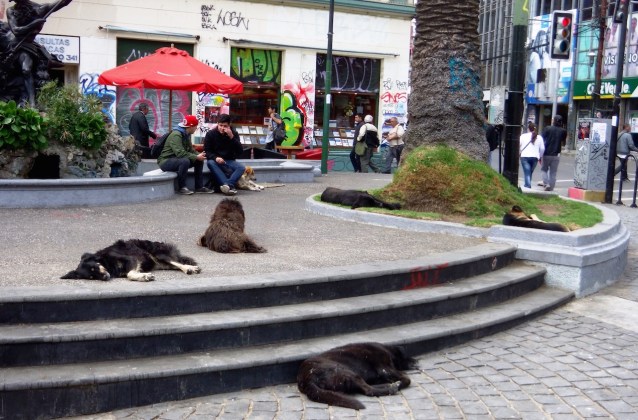
Back in Santiago on the last evening before our departure we sample just a little of Barrio Lastarria before dinner.
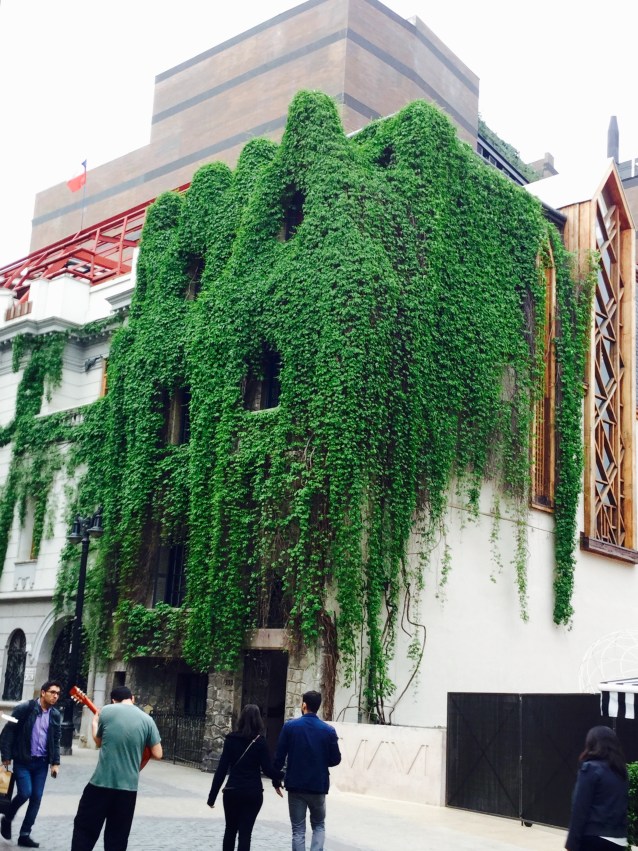
A stroll in the park close to the hotel, an appreciation of colonial influences on the architecture (Museo de Bellas Artes); then an empanada and a pisco sour, the music of a street performance ……..the journey is over.
“This is all. In the distance someone is singing. In the distance.” Pablo Neruda
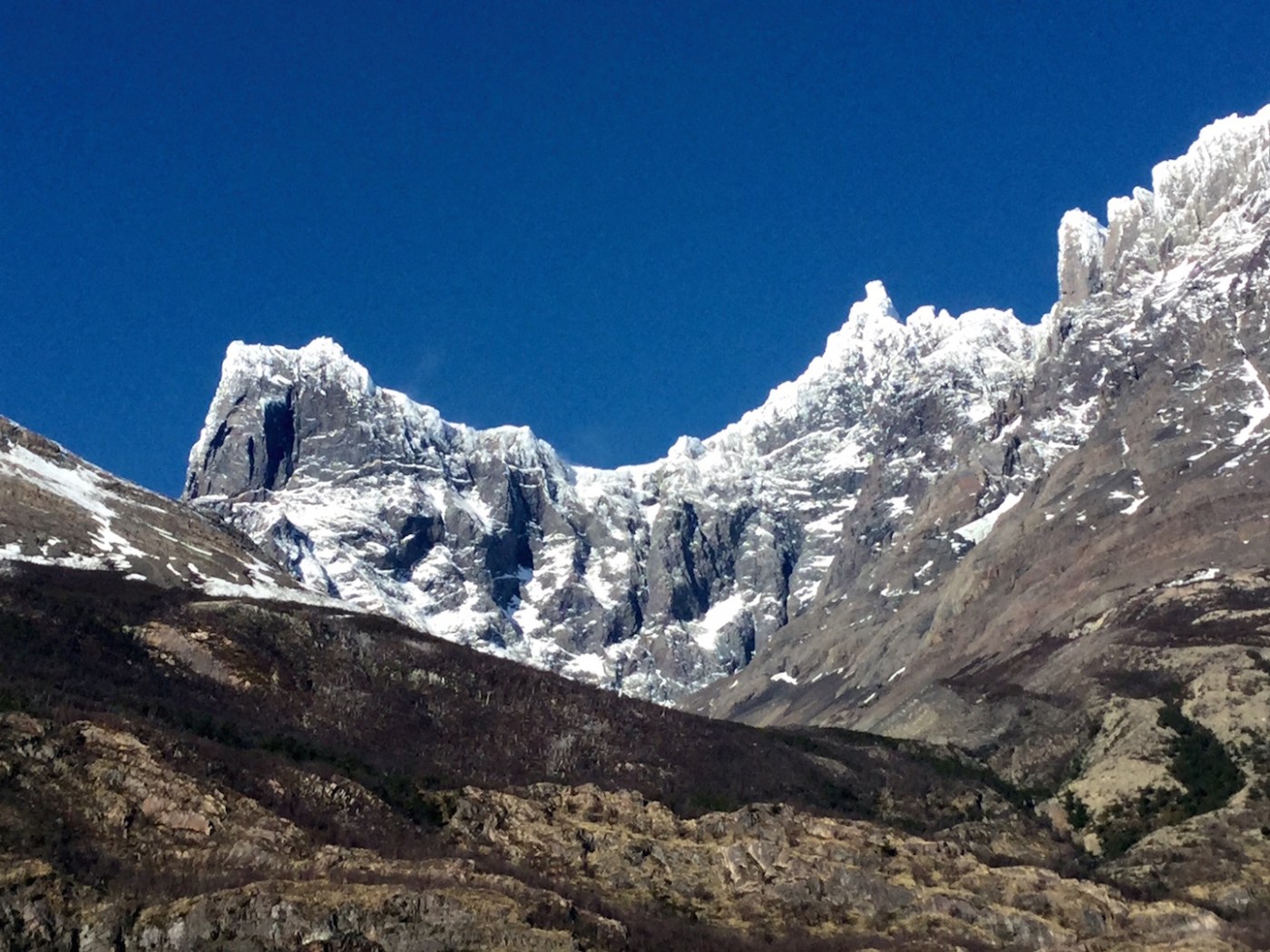
Images of a wild and beautiful place, the urging of a former guide in South America, and a romantic notion of the “uttermost ends of the earth” – all were convincing – so we followed the adrenalin rush of our experiences with Cruceros Australia to Tierra del Fuego and Cape Horn with a visit to Parque Nacional Torres del Paine – a UNESCO biosphere reserve since 1978 – and more time in amazing Patagonia.
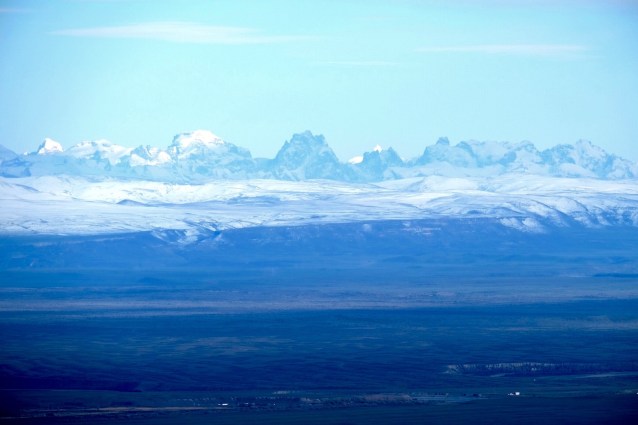
Our drive from El Calafate in Argentina on the first day provided a gradual introduction to the unique environments of the Magallanes and Chilean Antarctica region, including Patagonian steppe, Pre-Andean scrubland, Magellan forest, glaciers and watercourses.
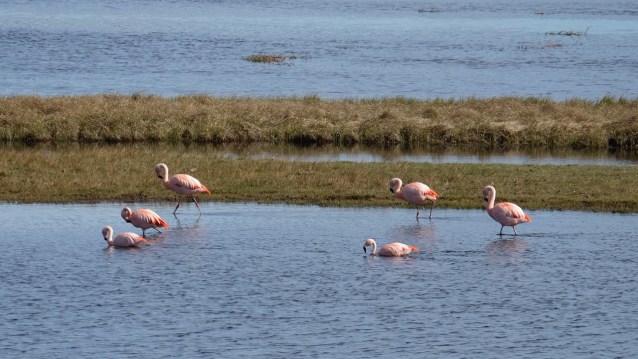

But nothing could quite prepare us for the location of the Tierra Patagonia Hotel on the shores of Lake Sarmiento and the ever present magnificence of the peaks or for the soft (but nonetheless amazing) adventure of a few more days at the end of the world.
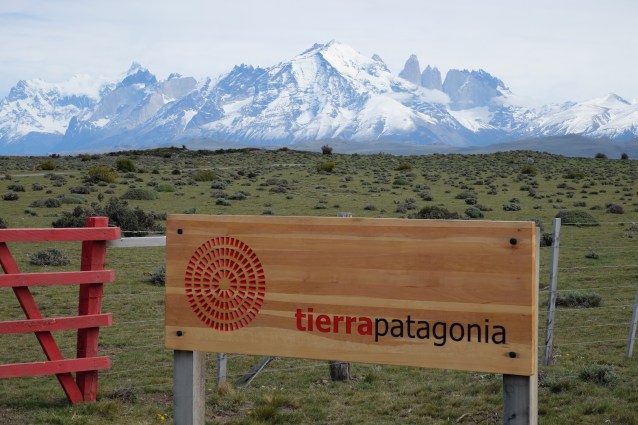
Tierra Patagonia Hotel is uniquely placed to provide visitors to the national park with an uninterrupted vista stretching from Paine Grande, including the “Cuernos” (horns), the “Torres” (towers), the Almirante Nieto and Nido de Condor.
The weather here can be notoriously changeable with bone chilling winds – it was not.
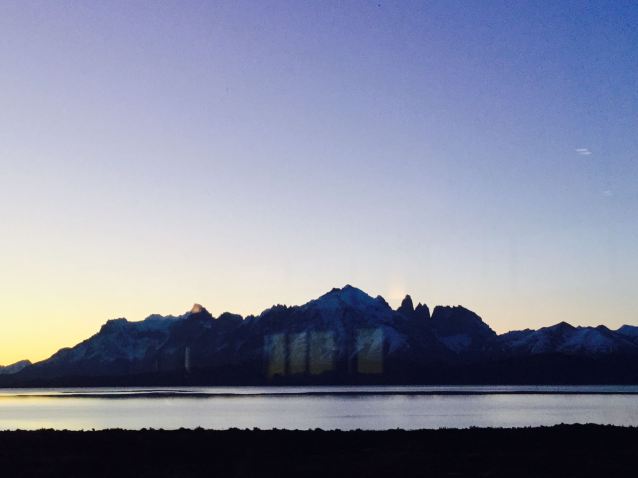
We saw sunrise, sunset, moon rise and moon set, reflections in lakes and the mesmerising presence of the peaks of the Paine Massif from different perspectives as we travelled on excursions, a navigation, hikes and on horseback throughout the park. We were spellbound by the 360 degree picture postcard moments but also felt utterly privileged to go out each day with our very experienced guides.
Thursday afternoon – arrival day – Cornisas (Cornices) hike

From this plateau we had stunning views of las Torres del Paine, Sierra Contreras and Sierra del Torro. The sky was blue, the breeze fresh but light and the condors were soaring and performing for the cameras.
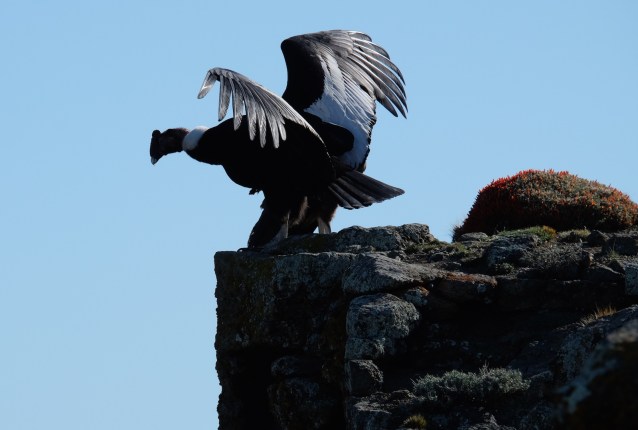
The unmarked trail was strewn with small flowering plants, the most notable the red mate guanacos.
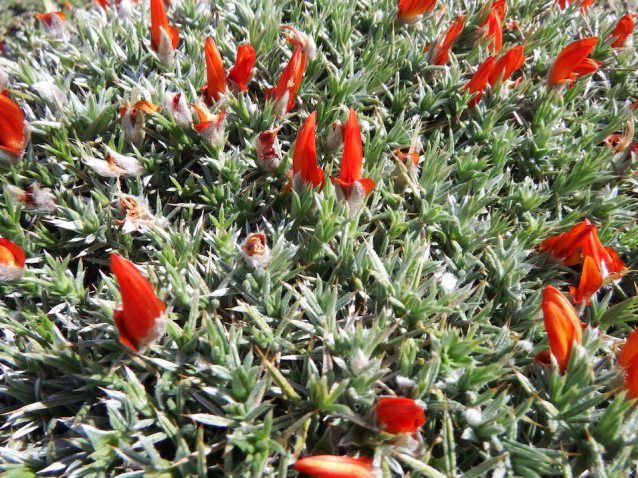
Our expert guide was relaxed but reassuring as we made a skidding, zigzag descent.
Friday morning – Hunters Trail

After a frosty start, the weather was again unbelievably bright, sunny and calm.
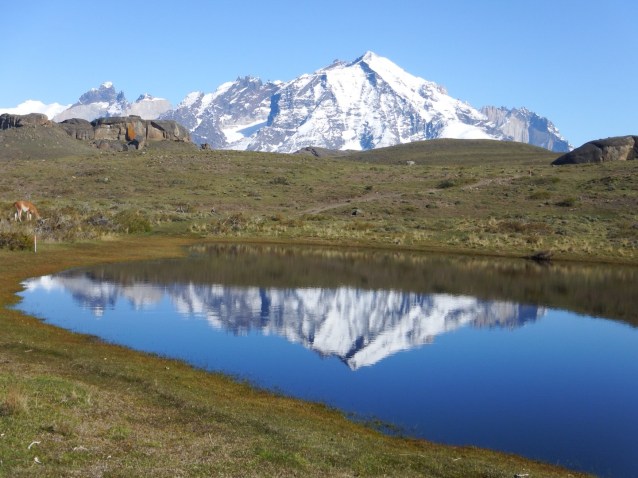
The trail gave us a chance to pass close to herds of guanacos.

A key focus was a visit to the rocky outcrop with “pinturas repestros de Aonikenk” – cave paintings of a native people who were hunter gatherers and occupied the area some 6,000 years ago.
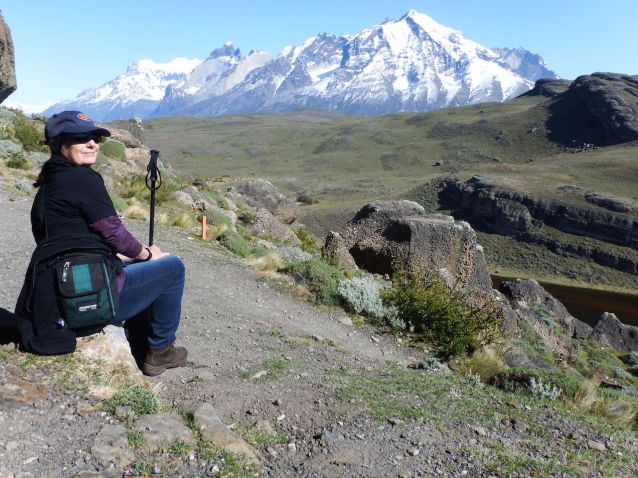
Again, the initial descent was a little challenging. It then became obvious that we were in the territory of a hunter – the puma (the predator of the guanaco).
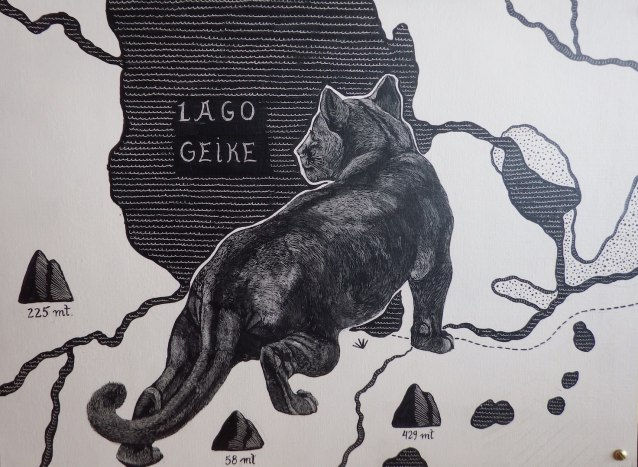
The grassy sierra was strewn with their remains – some recent kills. According to our guide, the nervous behaviour of the guanacos also indicated that a puma was not so far away.
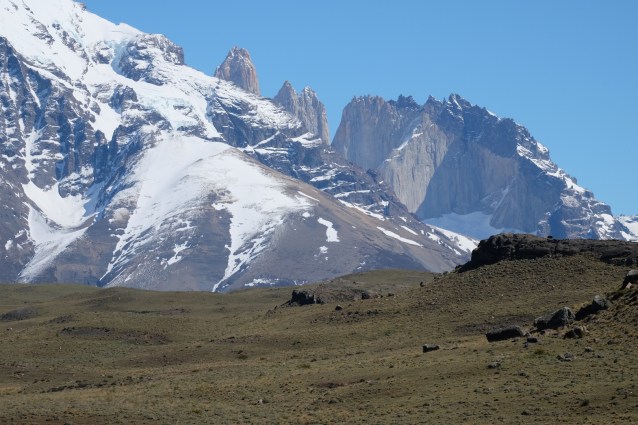
Friday afternoon – Laguna Azul
There was a relaxing option after lunch. A drive north to the Blue Lagoon, stopping along the way at the Paine waterfall – such a powerful, deafening surge of water and an exhilarating experience to walk along the path and feel the spray on our faces.
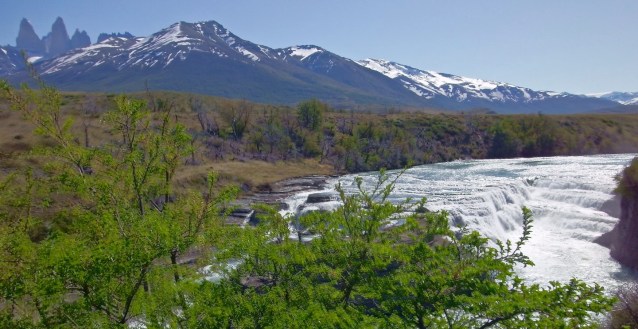
The picnic spot in the forest above the lake had more breathtaking views.
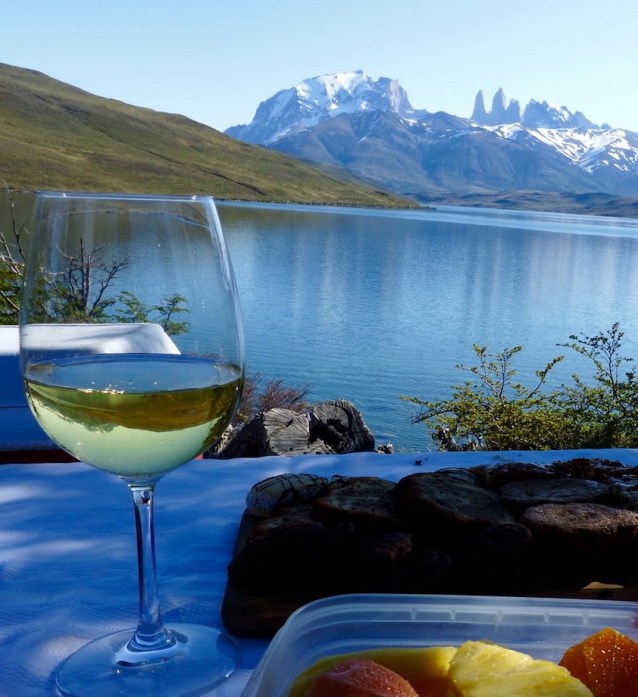
A curious (and obviously scavenging) Caracara approached us hopefully.
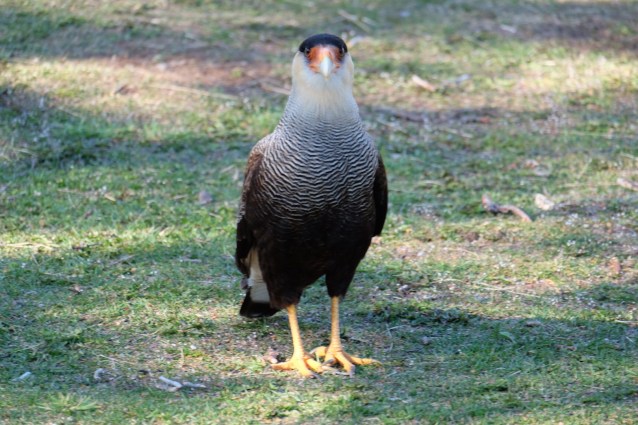
The picnic spread provided by the hotel included a refreshingly crisp white wine. Pure pleasure.
Saturday – full day including navigation on Lago Grey

A very long day but there was so much to see and do! The drive included stops along Lago Pehoe, views of another impressive waterfall on the Rio Paine, an informative visit to the administration centre of the park (CONAF), a “typical” lunch at Rio Serrano, a forest walk, a (stony) beach walk and a trip aboard the Grey II on the lake right up to the Grey Glacier.

We boarded the boat late in the afternoon for the cruise to the glacier.

The little boat was crowded and there was the usually difficulty for the photographers to that ‘perfect’ shot.
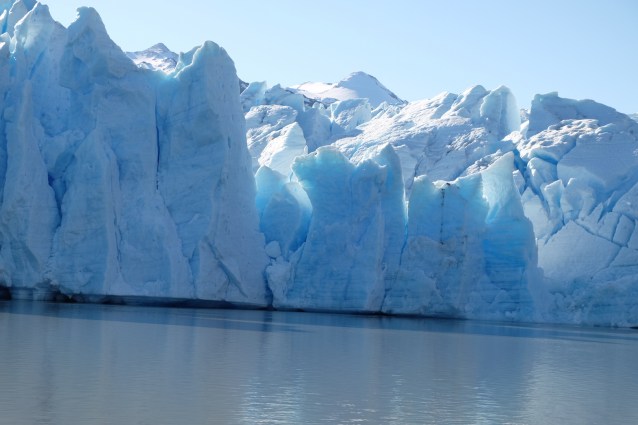
The sky again was a brilliant blue and the skyline of the Paine Grande was imposing. The boat manoeuvred among the ice floes along each face of the glacier – it was an amazing, if slightly unnerving experience to hear the ice crunching under the bow.
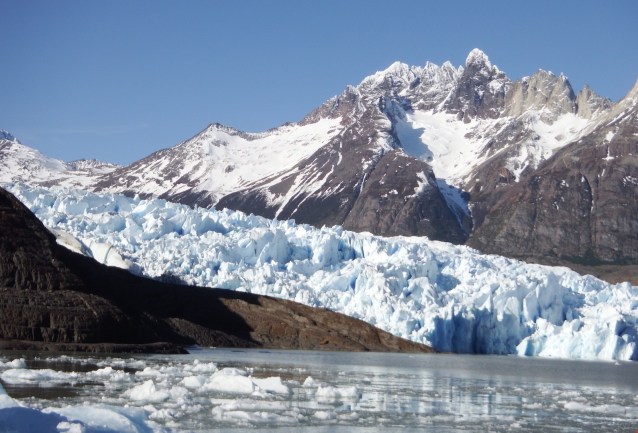
We would have appreciated a guide aboard the boat. This was not provided but the friendly crew offered pisco sours with clinking glacier ice.
Sunday – Baguales and Estancia Lazo

Our last day in this beautiful hotel – an option was to simply relax and experience its picture perfect location, sympathetic eco design immersed in the landscape with spa, library, relaxation areas, extensive picture windows overlooking the lake, dining room and bar. BUT we opted to go out again. In the morning after an interesting drive we reached a higher altitude and walked beside a stream looking for fossils.
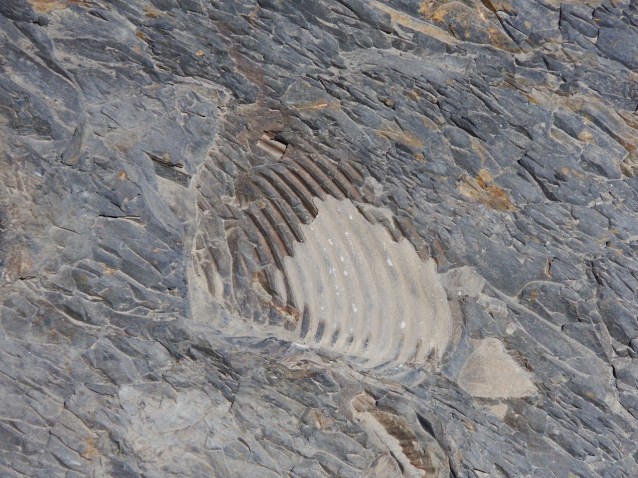
We were outside the park and crossed the boundaries of estancias. Wild horses roamed freely.

In the afternoon, eager for one last opportunity to be out in the park we spent a couple of hours horse riding accompanied by our guide and a couple of local gauchos, through ancient forest of lenga trees to a lookout point.

On the drive to the estancia (and during the drive south to Punta Arenas the next day) it was quite confronting to see how much of the forest has fallen victim to massive fires (2011) and ongoing destruction caused by a parasite (commonly called Chinese lantern).
Monday – departure
Soft clouds were dimming the brilliance of the southern sky and the wind was beginning to rise. It was time to leave. As a parting gesture, the manager handed me a password. It was the key to my ongoing connection to this land. If I chose to activate the link, Tierra Patagonia Hotel would plant a tree on my behalf as part of a renewal program for the depleted forest.
Our guide drove us on the long road south to Punta Arenas through a rather desolate open countryside of immense sheep stations. We turned for one last look at las Torres del Paine (towers of blue)), the condors wheeled in the air in farewell and flamingos provided a surprise flash of pink in the landscape.

Faithful pairs of upland geese were a constant reminder of a land appearing dry and desolate but carrying so much water in its lagoons, lakes, streams, rivers and glaciers – I added my tears in farewell.
“Why then – and this is not only my particular case – does this barren land possess my mind? I find it hard to explain…but it might partly be because it enhances the horizons of imagination.” Charles Darwin.
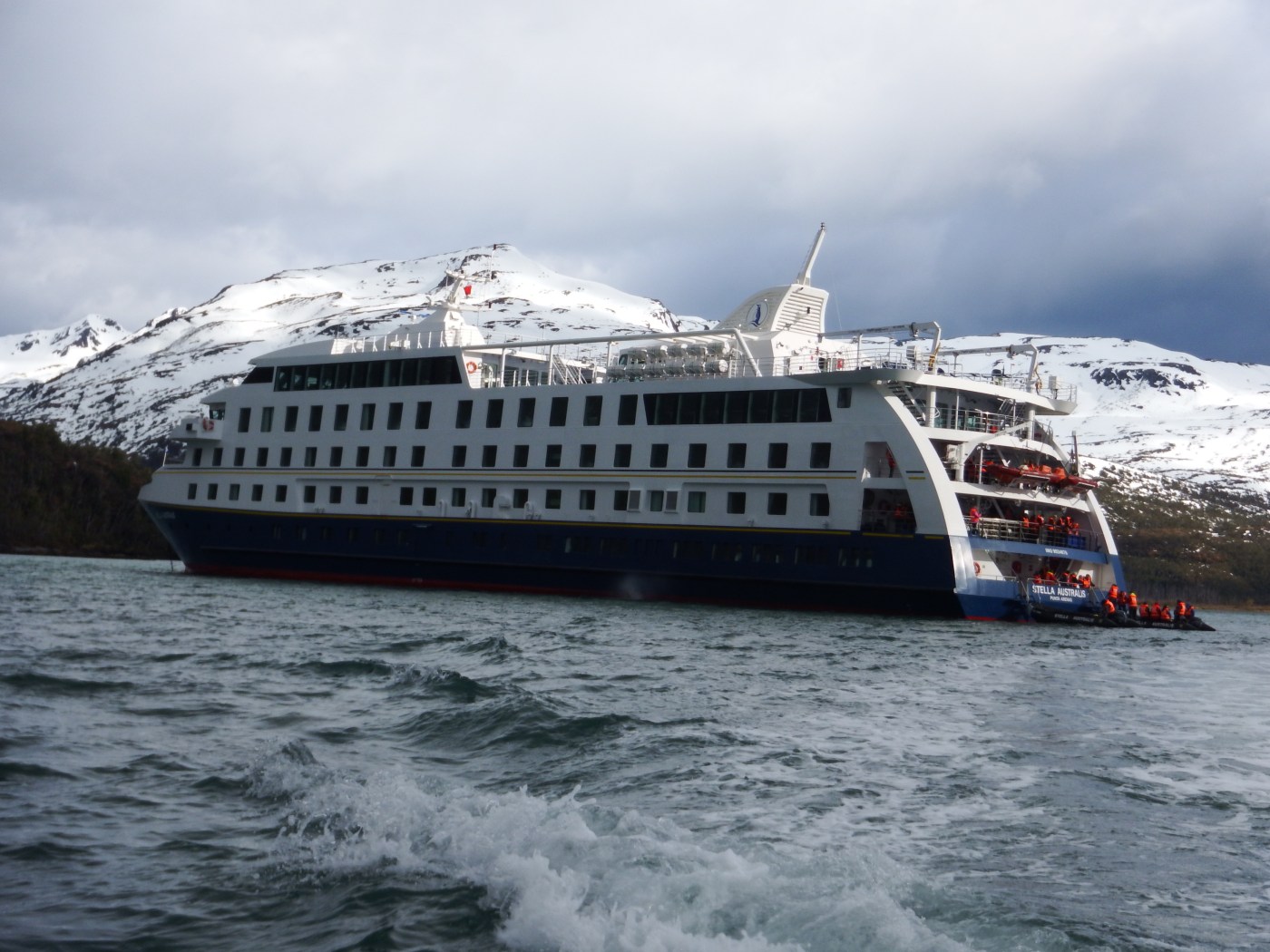
Saturday (Navigation – Punta Arenas/Ainsworth Bay 90 Nm)
The sky is clear, there is a fresh breeze whipping at the flags and the reception desk is a flurry of passports and boarding documents.
AAA Superior Cabin 422 on the bridge deck, Pisco Sours, a welcome toast in the Darwin Lounge (5th deck), meet and greet the captain and the expedition crew and then we are sailing into Estrecho de Magellenes! Everyone wants to be outside on the rails until the very last moment of the sunset before dinner is served in the Patagonia Dining Room (1st deck).
We embrace the shipboard rhythm of briefings, drinks and fine food – and anticipation of what tomorrow will bring.
Sunday (Navigation Ainsworth Bay/Tuckers Islets/Pia Glacier 208 Nm)
The Sky Lounge (4th deck) offers early coffee and fresh, gourmet pastries for those who are keen to photograph the sunrise or work out in the gym.
Today’s disembarkations are not testing physically but it is the first time wearing all the gear and following procedure for leaving the ship and returning in the zodiacs.
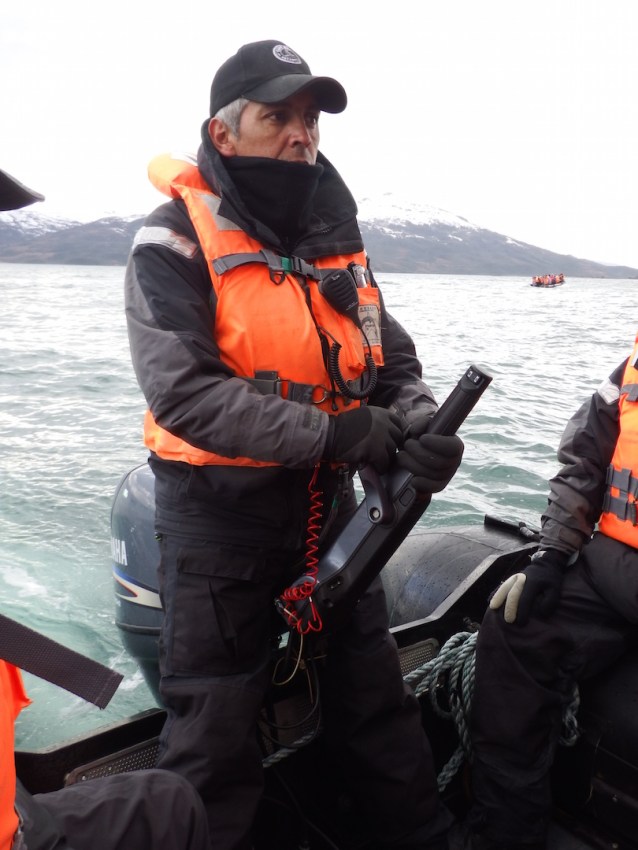
There is a shore excursion in the morning – we see our first condors of the trip, walk through an Antarctic beech forest, examine delicate marsh plants, mosses, lichens and mussel beds with our guide Javiera in the National Park Alberto de Agostini.
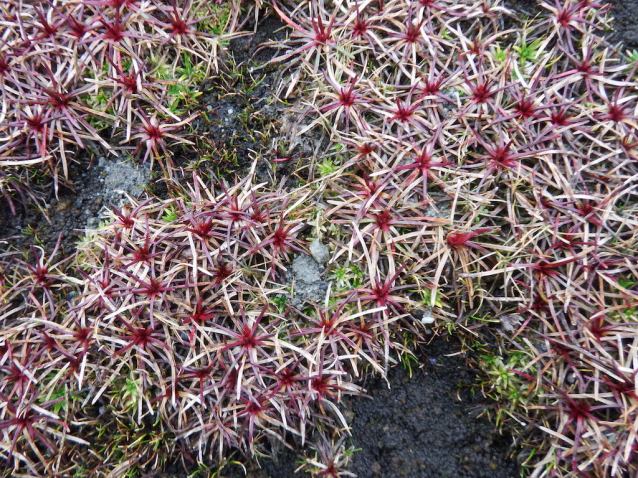

I could have stayed longer at the imposing rock face – no cathedral, no matter how soaring or ornate can possibly match the sense of ‘awesome’ as this remote, silent, natural place.
Prior to the afternoon disembarkation to view penguins and cormorants at Tuckers Islet, there is some trepidation about the sea conditions but the crew ensures that the expedition (although thrilling) is quite safe despite the 30 knot westerly wind. AND we see another condor. BUT there are fewer penguins than usual – fewer each year.
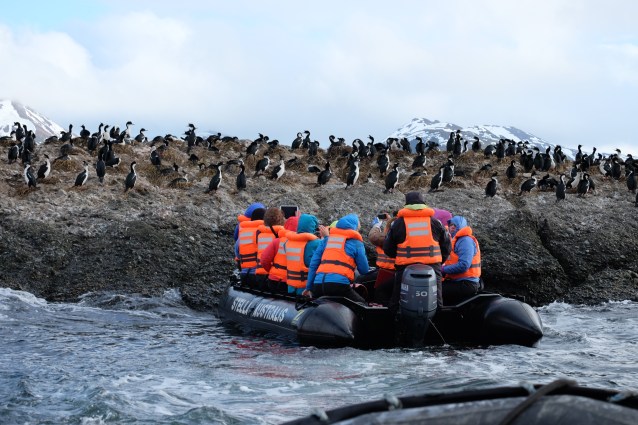
The evening lecture is Glaciology in Patagonia and after the briefing for the next day, there is very little energy for the other entertainments provided.
Monday (Navigation – Pia Glacier/Cape Horn 142 Nm)
There is high excitement as we sail in Ballerno Channel as the clear, early morning weather deteriorates. Snow flurries! The disembarkation for Pia Glacier goes ahead although there are a few modifications to the excursion on land because of the snow. It is quite amazing to be so close to the ice and very satisfying to experience this chilly place while drinking whisky and hot chocolate.
We are anticipating a perfect sail through Glacier Alley and are keen to capture all five glaciers on film. It is not to be. The snow increases and there is almost complete white out. Disappointment is put aside as we anticipate the itinerary for the next day and the bar provides drinks and snacks and opportunities for interesting talk with new acquaintances.
Late in the afternoon there is a briefing for the next day’s morning excursion – Wulaia Bay. And in the evening, the Captain’s dinner.
Tuesday (Navigation – Wulaia Bay/Cape Horn 78Nm; Cape Horn/Pto Navarino 94 Nm; Pto Navarinot/Ushuaia 20 Nm)
This place is steeped in history and legend. Captain Fitz Roy, naturalist Charles Darwin, Yaghan aborigines….the stories are wonderfully and meticulously curated in an old naval station. However, as we disembark for the hill hike in Wulaia Bay, our thoughts are on the viewpoints far above us which we will strive to reach. There was fresh snow overnight but now the forest is a winter wonderland (even though it is October and officially Spring).
The track is muddy and the climb long and steep but well worth the effort as we reach the viewpoint and see Stella as a tiny toy on the bay below. There are photos and a minute’s silence to appreciate the pristine environment and breathe the clear, cool air. No sound except the rushing water of an icy stream.
This day yields another excitement late in the afternoon. The captain and crew keep us in suspense as they assess the sea and landing conditions on Isla Hornos – the ultimate experience for most on this expedition is to reach Cape Horn AND go ashore to the monument. After the satisfaction of the morning climb in Wulaia Bay, I am feeling that Cape Horn would be an extra bonus.
The disembarkation begins. I am on the second boat to land and push myself to climb to the monument – then race to the lighthouse and back down to the landing spot in the fading light for the first zodiac back to the boat.
It is time for the farewell toast all too soon. I really wanted a very special keepsake for us to take home – there was a raffle for the 150th voyage flag (the Jack) and an auction of the nautical chart too. But I am happy with the Cape Horn stamp in my Passport and the memory of an unforgettable expedition cruise. The Stella Australis is a beautiful boat with an exceptional crew. I am forever spoiled – cruising for me can only be on a small ship like the Stella – preferably with a barman who understands that champagne is my first love but Pisco Sours come a close second.
Wednesday – Cruise destination – Ushuaia
The voyage destination is Ushuaia, Tierra del Fuego, Argentina – a stepping stone to El Calafate and the next part of our journey in Patagonia.
We have sailed and walked in this remote area of legends, pristine waters, the albatross and the ancient ice of the Darwin Range glaciers….we think we have been especially privileged to have had the opportunity to be here.
Our next destination is back in Chile in the Torres del Paine National Park. Another very special place on earth.
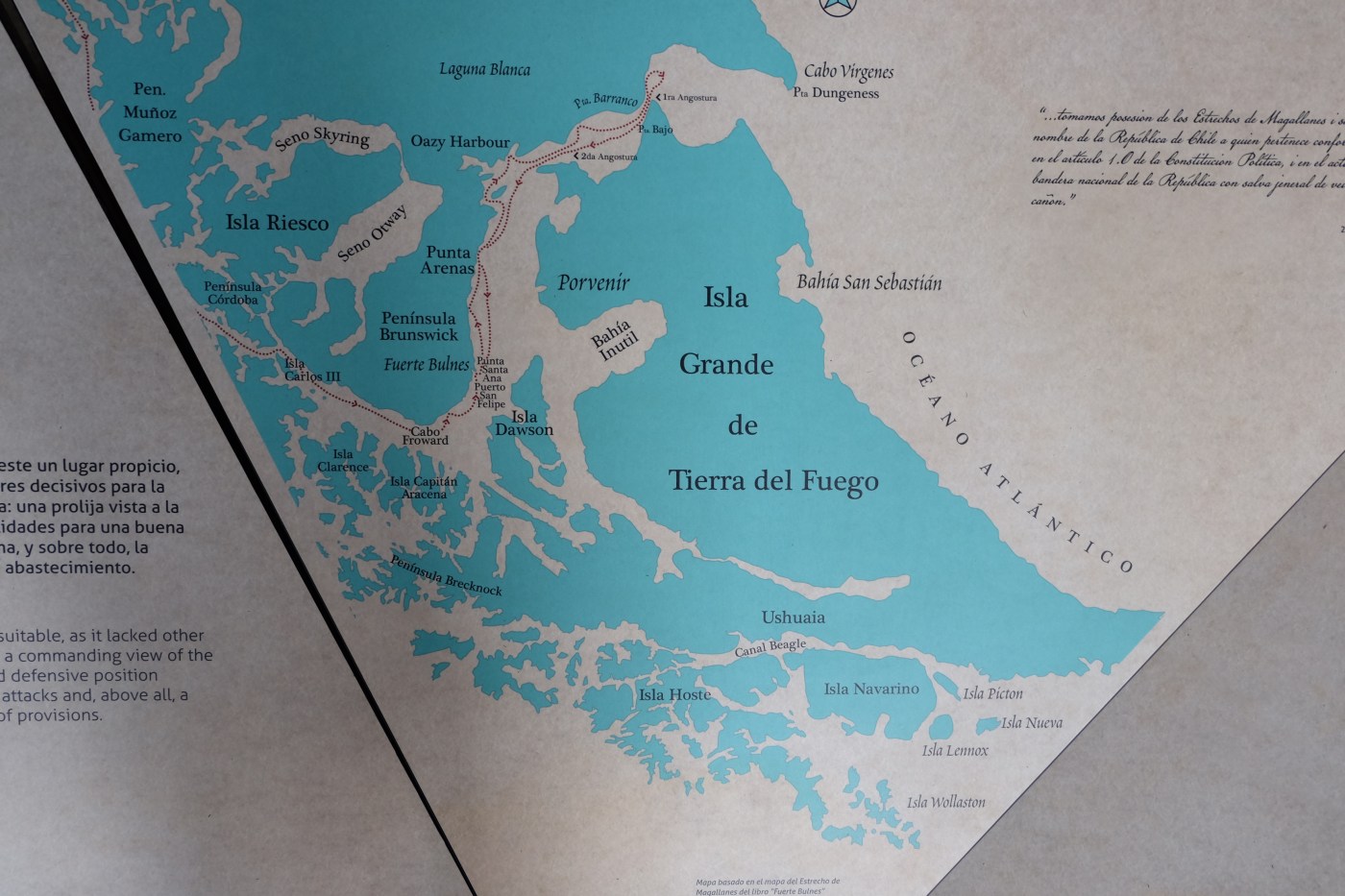
Punta Arenas, Southern Chile – some history, a view across the Straits, a bar and a boat
Our arrival on a delayed flight from Santiago is at 1.25 am. Anticipation of what we will see in daylight is high. This town is the gateway to our expedition cruise to Cape Horn.
The next morning the interior detailing in Hotel Cabo de Hornes gives a sense of the history of this place.
In the following week we are to learn a little of those who were here long before us. Before the Europeans, Indian nomads hunted on land and sea – Aonikenk, Onao, Yamanas, Qanasqar. Only a handful survived the subsequent arrival and colonisation by Europeans.
A sunny, morning stroll across the central square reveals an obvious hero, Hernando de Magellanes. Also on the statue is a native Indian. Rub his foot and you will be sure to return – or so the story goes.
A short drive along the Pan American Highway to the south is Fuerte Bulnes. This fort was established when the Chilean government sent an expedition in 1843.
The site was unsuitable and Governor Jose Santos Mardones founded the city in its present location as a penitentiary colony in 1848. Punta Arenas flourished. Sheep “white gold” were introduced; immigrants from Europe came in search of gold. Then, a large part of the city was destroyed in terrible mutiny in 1877 but by the end of the century with a reduction in the number of prisoners, the city became safe for enterprise to flourish. Wool and timber generated wealth. Palaces and estancias, mansions and other significant buildings such as the opera theatre were testimony to this prosperity.
Until 1920 when the Panama Canal was opened, Punta Arenas thrived due to its proximity to the Straits of Magellan and the trade that passed between the Atlantic and the Pacific. Coal, gas and oil (in addition to livestock industries), have ensured that this province continues to prosper.
On a night with a cool, fresh breeze and a clear, moonlit sky we found Punta Arenas historical centre to be a lovely place to walk, find a bar, have a drink and sample the spicy, flakiness of empanadas.
There is the boat! The first view of her from Cerro de la Cruz, a viewpoint above the town, brings home to us how far we are away from everything we know and how much we are looking forward to the voyage.
We have checked in. There was a heart pounding moment when I fumbled through the folder looking for the Argentinian visa papers – after 3 days and 4 nights sailing, Stella would take us to Ushuaia, Argentina – the most southerly town in the world.

Back to the high altitudes of La Sierra – this time in the south. Cuenca, Ecuador is the capital city of Azuay province and enjoys a cool climate at 2500m above sea level. Our plan is to wander at leisure in this lovely city, visit a local family who run a panaderia (bakery) and drive to Chordeleg and other nearby villages before returning to the coast the next day.
Part of our road trip from La Costa is shrouded in mist and cloud. When we reach the National Park (Parque Nacional Cajas) – gateway to the mountains – to photograph the lakes of glacial origin, we are more than 3000m above sea level. It is now relatively clear, windy and very cold on this October Saturday.
Cuenca was founded in 500 AD as a Canari settlement – “a land as big as heaven”. When the Spanish arrived in 1557 to establish the walled colonial city that stands today, both the Canari and the Inca who had followed them, had abandoned the site.
Cobblestone streets, colonial parks, squares, churches and cathedrals and museums – Cuenca today is a UNESCO World Heritage Site.
On Sunday we take a very scenic drive. The pretty town of Chordeleg with its silver and ceramics shops will be the first stop. Our driver, Sergio, has a plan to select a roadside cafeteria for a “typical” family Sunday lunch before visiting his father’s village of Sig Sig. The Pan American Highway will then provide a fast route back to the coast. Hairpin bends, heavy traffic and double lines seem to be of little consequence to our driver and certainly do not slow the speed of our descent from the mountains!
We took few photos on the return to the coast. We were too busy holding on tightly as Sergio drove skilfully (but VERY fast) through the pretty green valleys, sleepy villages, rolling farmland, cloud forest and then the flat rice fields and sugar plantations to reach the outskirts of Guayaquil. The equatorial sunset was incredibly dramatic – huge red sun, golden, hazy light, soft mauve dusk.


The promised volcanos of Ecuador were elusive, lost in the clouds and mist along the route. Cayambe, Pichincha, Cotopaxi, Tungurahua, Chimborazo. Instead, the changing panoramas of villages and farmlands, forests and rivers moved sedately past our windows as Tren Ecuador took us on a leisurely journey from the mountains to the coast.
Encounters with artisans, musicians, crafts men and women and other producers were arranged at each of the many stops.
One of these, San Antonio de Ibarra, is internationally recognised for its wood carvers, great artists and sculptors who have given continuity to the XVth century-born Quito School of Art.

El diablo – San Antonio de Ibarra
Many along the Tren Crucera route would rely on the patronage of travellers to supplement their incomes and revitalise the village economies.
The knowledgeable guides, Sixto and Adeline, gave so much interesting information about this land and the culture of its people. The itinerary had been designed to give a variety of opportunities to understand Ecuador’s history as well as the geography, geology and economy.

Fabrica Textil Imbabura – a museum in Andrade Marin
The service staff in the train’s cafeteria/bar, the suppliers of fresh fruit and snacks on board, the accompanying outriders on motor bikes, the security guards staff and stall holders at the stations, and of course, the crews of the steam and diesel locomotives, all had jobs dependant on the successful operation of this venture of Tren Ecuador.
Large international companies like Nevado Roses put out the welcome mat for Tren Crucero and provided guides for tours. Rose production makes a significant contribution to the economy of this region in Ecuador.
Haciendas and restaurants were obviously delighted to make Tren Crucero welcome for our overnight stays and lunchtime repasts.
Colourful market stalls were everywhere, proudly displaying colourful Andean handcrafted items in wood, ceramics, beads, wool and other textiles. Market day in Guamote was a special stop. This was a day for local people to trade and although our patronage was welcome, the focus was not on us, but on a busy, family day out.
There is one section of this train track which deserves a special mention – Devil’s Nose – an incredible feat of engineering. (This near-vertical wall of rock was an obstacle to overcome when the rail line was first built to link Guayaquil and Quito (1899-1908). A series of tight zig-zags were carved out of the rock which allowed the train to climb 800m at a gradient of 1-in-18 by going forwards then backwards up the tracks).
A special highlight for everyone on this trip followed a tour and information session at a cocoa plantation. Producers are very proud of this industry which provides the resource for another industry – chocolate! And then…. LUNCH! At the stunning Hacienda La Danesa.
But of course, nothing can surpass the excitement of a steam engine, with all the noise and fuss when it is shunted in to replace the diesel locomotive for the last part of the journey – from Yahuaci to Duran.
What a journey Tren Ecuador! Ama la vida!
Tren Ecuador can be very proud of its faithfully restored steam engines, rebuilt railway tracks, gracious carriages and immaculate stations. The Tren Crucero route opened our eyes to the country and its people.
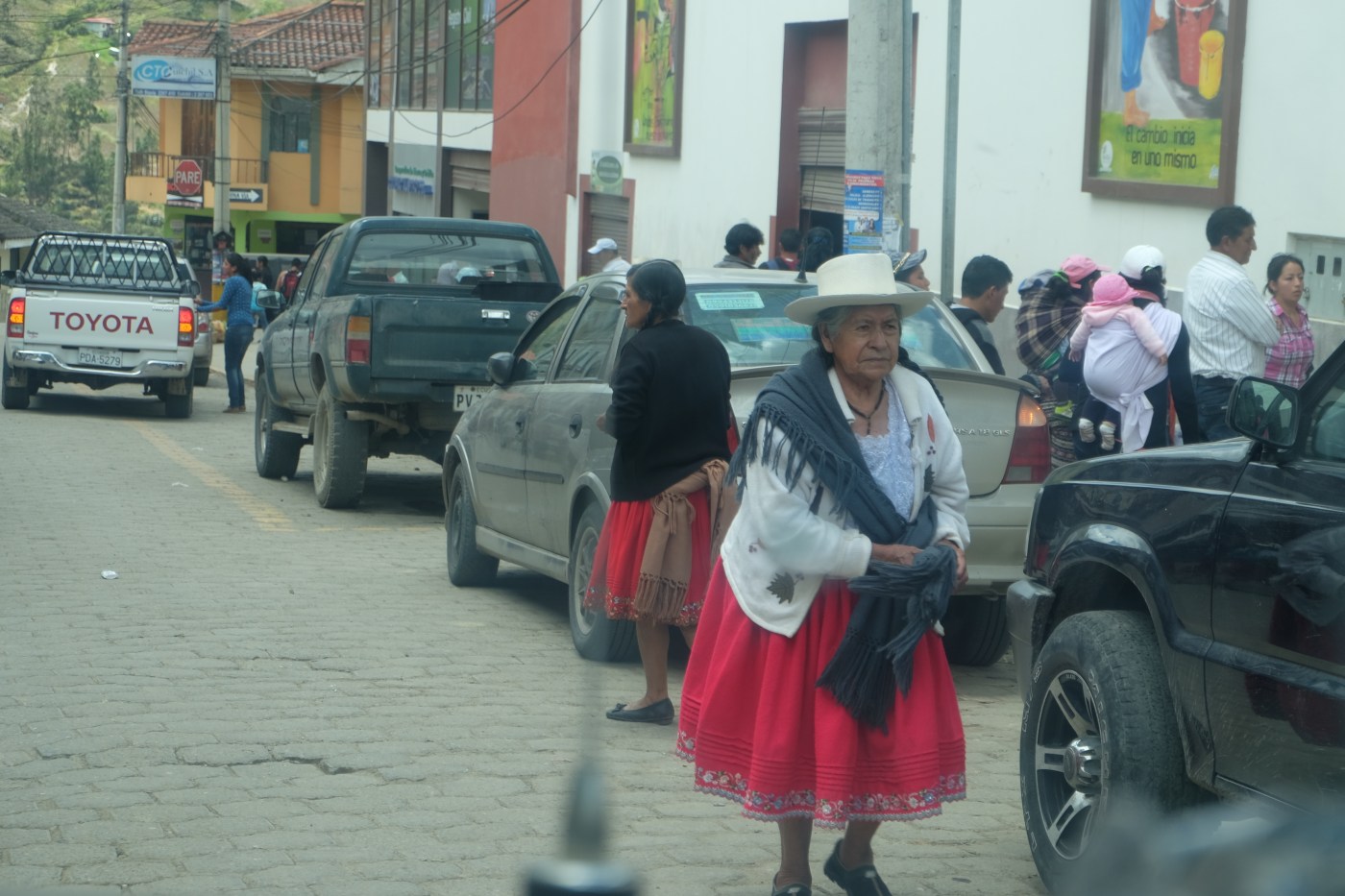
The people are proud of their cultural and geographic differences. To a stranger who does not speak the language, it is difficult to absorb more than a superficial understanding of this cultural difference without some serious research.
The physical landscape transitions from the rampant green growth of sugarcane, bananas, rice and cocoa plantations through the ferny and treed “cloud forest” to the high and much drier landscape of the true Sierra. At the highest altitude there is a more alpine appearance. There are green valleys which support chequered farmlands and picturesque and traditional Spanish buildings – white with terracotta tile roofs. Black and white dairy cows make it seem almost European.
The cities, towns and villages are crowded and the covered mercados are packed and stifling. On the humid coast the common dress is predominantly Contemporary in style; jeans and T-shirts for men and variations of tight fitting jeans or leggings and skimpy tops for young women. In the highland areas the youthful uniform is much the same but the older men and the women in particular, are striking in their traditional clothing. Distinctive hats, and the colours of shawls or capes and skirts are indicative of the particular area. The peoples of Ecuador are quite short in stature. Their diet is normally high in starch from potatoes, rice, beans and corn. This is now supplemented with inexpensive, readily available and highly refined foods inevitably labelled “ALTO” in either salt, sugar or fat or all three.
As I struggled in the higher altitudes, I marvelled at the stamina of tiny, wizened old men and women walking up steep hills and carrying very large loads slung in big baskets or sacks over their shoulders.
Children are obviously nurtured by all but they can be seen alone or in groups quite independent of adults in situations where our parenting style would demand closer supervision. Teenagers and Millenials look like young people everywhere – particularly in towns and city streets. The young men obviously pay close attention to branded clothing and cool haircuts and young women to meticulous application of make-up, hair styling, glittering accessories and tight, body hugging stretch fabric.
While there are quite obviously wealthy and middle class communities within these towns and cities, So many of the people in the streets seem “poor” to our Australian eyes. Many dwellings in the country are little more than basic shelters and even in the towns with their more affluent suburbs there is an array of haphazard buildings – some in ruins, some apparently abandoned but actually ‘under construction’ as funds become available; in many areas the houses have small, untidy gardens with a few chickens, ducks or geese and maybe a vegetable garden or some fruit trees. Further into country areas there may be a few pigs. Some homes are brightened with flowers and most have at least one sleeping dog. The dogs may be part of a household but most look, at the best neglected with matted coats and at worst, diseased. Inevitably there is washing to be seen strung on a variety of inventive outside lines.
BUT who are we to say these people in a land and culture strange to us are “poor”? Without interacting with them we do NOT KNOW THEM. We do not know how satisfied the might be with what, for many, is probably a subsistence style of living.
The markets and roadside stalls are amazingly abundant in produce of all types – especially fruit and vegetables; street food stalls, household goods, the inevitable array of bright plastic gadgets and toys; all spill out onto pavements from tiny shopfronts or are crowded together in the covered mercados. Handcrafted clothing, the ubiquitous tight jeans and branded T shirts beckon and most of it, apparently, is for local consumption.
It is fortunate that the roads (on the whole) are good because the traffic can be daunting. There are heavy fines for exceeding speed limits but other rules seem to be optional. Depending on the driver, the journey can often be a hair raising experience.
I would much prefer to take award winning photos to record the experience. I will add a few to highlight points in my observations. Note to self; if you have not mastered the basics of the language or learnt about the history and culture of the places you travel to before your visit, your experience will be so much diminished.
Next post – Glimpses of places visited in Ecuador – photo story
LEAVING AUSTRALIA – ARRIVING IN SOUTH AMERICA
Day one
ON a breezy Spring day we fly out of Sydney through the Heads – almost feels like we are sailing away instead of looking down from the pointy end of a 747-400 ‘Fraser Island’. The name seems to make a personal connection to our coastal Queensland home – we will be safe on this first step in our journey which will take us from Ecuador to Patagonia during August and September.
It is the same date but seems like an eternity since leaving Sydney. A stunning sunrise over the Southern Ocean will be one of the ‘wow’ moments to remember; then as we fly closer to our first destination, gradually the coastline of South America is revealed. The snow covered Andes are there too and will be a backdrop to many of our days from Ecuador’s Tren Crucera trip and later when we travel in Chile. Santiago is just a stop over today – we will return in October.
Days two and three
The arrival in Guayaquil in the evening was initially reminiscent of a first experience of other balmy evenings in Hawaii or Mauritius. The same soft, warm air and soft calls of birds and frogs.
During the day Guayaquil downtown and the Malecon provide a glimpse of the city and the extensive recreational and commercial development on the bank of the river Guaya. Horns blaring, families out to wander through the malls of the Malecon and the city streets, a few stray cats, and stalls holders setting up for weekend activities. There are some lovely trees and garden areas and some gracious, if faded remnants of old buildings facing the river contrasting with the utilitarian, unattractive and rather grubby city centre. It is too warm (31C) and we retreat to the hotel to recover from jet lag.
Interesting to drive to another suburb of Guayaquil for a private lunch today. Samborondon is over the water via a bridge and we are dropped back into 21st century suburban life complete with mega malls , gated communities and estates with middle class families, dogs and kids on bikes. The discussion ranges from options for university, estate facilities, jobs for classes of workers, holiday plans, work and lifestyle and Australian crocodiles, sharks and snakes as well as our beautiful beaches. Time to pack for tomorrow’s flight to Quito and to ‘La Sierra’ and Tren Crucera.
LA SIERRA
Guayaquil to Quito
TAME were very efficient and it was surprising that Guayaquil airport was open, airy and not at all crowded. Our Tropic guide in Quito was very keen to get us to the car as quickly as he could. The new highway was fast – with police every 200m – we learned later WHY.
Hotel Patio Andaluz was full of character, a quiet oasis in colonial style with wide verandas, heavy timber furniture and interesting art pieces – and very tiny bathroom. There was a little confusion initially about the early departure the next day but a breakfast box was arranged. Before lunch we walked to the Presidential Palace through ranks of police, barricades and crowds of locals and discovered that the square had been taken over by a huge rally. There was a meeting of the presidents of Bolivia,Venezuela, Columbia and Ecuador’ Correa.
Lunch was in a cafe in a side street away from the crowds and opposite the partly restored Simon Bolivar Theatre. Another foray in the early evening took us to the San Francisco museum and convent. There was a thundery sky so back to the hotel for a cocktail in the garden courtyard.
That did little to steady the dizziness from the high altitude. ( Quito is 2850 m above sea level). Dinner there was pleasant in the central courtyard.
TREN CRUCERA
Quito to Quito
A very long day!
Chimbacalle station – Ibarra – San Antonio – Andrade Martin – San Roque – Otavalo –
We saw glimpses of Cotopaxi emitting ash as we drove in the bus to the northern Andes and the White City of Ibarra. Aboard Tren de Los Lagos to Otovalo with excursions to artisan wood carving (photo Le Diable) at San Antonio de Ibarra and Fabrica Textil Imbabura. Off the train at Otovalo and lunch at Puerto Lago Lodge which was a breezy location right on San Pablo Lake. There was a very LONG bus trip back to Quito. We were absolutely exhausted but joined in the ‘special’ dinner in the restaurant at Hotel Quito.
Quito to Abrasprungo Hacienda – a lovely day!!
Cunchibamba – Ambato – Urbina
Steam train from Quito to Tambillo ( rest place). A visit to a Russian owned rose plantation ((Nerado) to see the roses grown specifically for export. Lunch in a beautiful courtyard restaurant – the Roka Plaza – at a table with the guides in the town of fruit and flowers – then the train from Ambato to Urbina. A highlight of the day was meeting the 71 year old “last ice maker” at Urbina. It was 6 degrees outside with a cool breeze but everyone was keen to know his story – as told by guide Sixto. The afternoon’s journey was then sabotaged by the film crew on board who wanted us as extras in a little bar scene with Santiago the barman. Christina was not at all keen. It was a late arrival at Riobamba but there was a brass band playing and film crews everywhere. This is obviously part of a big effort to promote the Tren Crucera and boost the flow of income to the towns along the route. We drove on to the very lovely Hacienda Abrasprunga. The rooms were in separate patio bungalows – ours had a huge picture window overlooking the lawn.
Riobamba to Bucay
Riobamba – Colta – Guamote – Alausi – Devil’s Nose – Bucay
A Zumba class was in progress at the station as we took the steam train from Riobamba to Colta. A visit to the first church built in Ecuador, a little market browsing for some then on to Guamote for the huge local Thursday market on the town streets. Lunch was served on the train; then the highlight of the afternoon was riding the spectacularly engineered Devil’s Nose switchback section. Overnight was spent at “tourist” Hotel d’Franco in the cloud forest where the staff were so very keen to please.
Bucay to Duran
Bucay – Naranjito – Yaguachi – Duran
The last day was full of special surprises. The train took us through coastal plantations of sugar, cocoa, pineapples, balsa, teak and rice. There was a visit to a cacao farm where there was much bragging by the guides about the fineness of Ecuador’s cocoa and chocolate for export. Hacienda La Danesa was a paradise on earth and the chef was applauded by all after a gourmet lunch. Then followed the unique experience of watching and photographing the historic and restored steam engine replace the diesel locomotive with much whistling and tooting for the run into Duran. Another surprise was cocktails provided by the guides in the cafeteria car AND a 3 man drum, guitar and pipe band playing vibrant South American music. At Duran our group dispersed to taxis or the bus for hotels in Guayaquil.
Weekend in Guayaquil
Back to base at Hampton Inn, 9 de Octubre Boulevard. Oasis in time to upload photos, catch up on sleep and have a lazy weekend. Despite some travel related unsettled stomachs we do manage to have a lovely evening walk to the cathedral and Seminario park to see the iguanas and then to the quite elegant colonial government precinct and back through the warm and noisy Saturday night throng before a late supper. On Sunday for a spot of extra outfitting for the Patagonia part of the trip, a $5 taxi ride delivers us to Mal de Sol to mingle with the families on a Sunday shopping excursion.
San Carlos work days
Our travel mode is suspended as the work part of our trip commences. We are driven from Guayaquil to San Carlos plantation by Sergio and installed in the guest house. For Graham it is straight to work; for me an exercise in discipline to attempt some study of Spanish. There is no one else here during the day except a rather abrupt houseman so I will have to manage the solitude and the sound of my own voice.
A walk in the immediate compound area reveals some residences with flowery gardens, a few pretty little birds and the constant noise, dust and smell of a sugar mill operating 24 hours a day. AND mosquitos!!